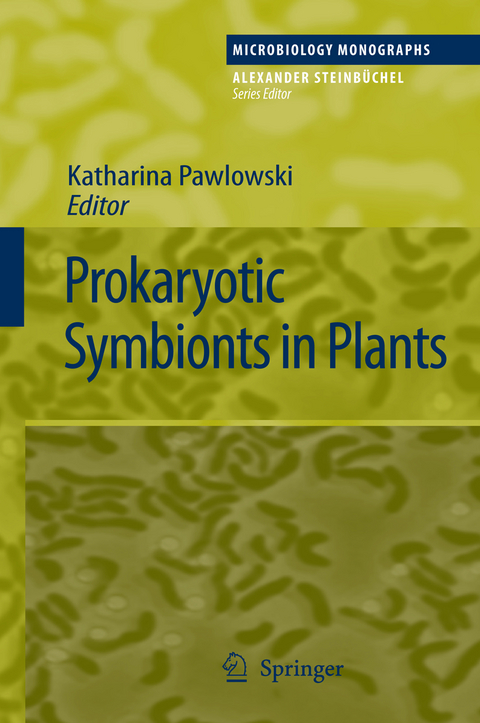
Prokaryotic Symbionts in Plants
Springer Berlin (Verlag)
978-3-642-24259-5 (ISBN)
Endophytic prokaryotes can invade the tissue of the host plant without triggering defense reactions or disease symptoms. Instead, they promote the growth of the host plant due to their ability to fix atmospheric dinitrogen and/or to produce plant growth-promoting substances.
This Microbiology Monographs volume presents up-to-date findings on the interactions between plants and beneficial prokaryotes, including the use of genomics for the analysis of plant-prokaryote symbioses and their evolution. Rhizobia-legume, actinorhizal and cyanobacterial symbioses are presented.
Rhizobia-Legume Symbioses.- The Diversity and Evolution of Rhizobia.- Erratum to The Diversity and Evolution of Rhizobia.- Making Rhizobium-Infected Root Nodules.- Functional Genomics of Rhizobia.- Actinorhizal Symbioses.- Evolution and Diversity of Frankia.- Induction of Actinorhizal Nodules by Frankia.- Physiology of Actinorhizal Nodules.- Cyanobacterial Symbioses.- Physiological Adaptations in Nitrogen-fixing Nostoc-Plant Symbiotic Associations.- Why Does Gunnera Do It and Other Angiosperms Don't? An Evolutionary Perspective on the Gunnera-Nostoc Symbiosis.- Cyanobacteria in Symbiosis with Cycads.- Structural Characteristics of the Cyanobacterium-Azolla Symbioses.- Relations Between Cyanobacterial Symbionts in Lichens and Plants.- Diazotrophic Endophytes.- Diazotrophic Bacterial Endophytes in Gramineae and Other Plants.
Aus den Rezensionen: "Die zwölf Kapitel dieses ... attraktiven Buches sind ... auf dem aktuellen Stand. ... Im Kapitel über die Entwicklung der Actinorhiza-Organe stellt die Herausgeberin die Besonderheiten dieser symbiontischen Interaktion im Vergleich zu den durch Rhizobien induzierten Organen detailliert und übersichtlich dar. ... Auch die Symbiosen mit Cyanobakterien sind mit vielen neuen Ergebnissen in den folgenden Kapiteln anschaulich dargestellt." (Dietrich Werner, in: BIOspektrum, February/2010, Vol. 16, Issue 1, S. 124)
Aus den Rezensionen:
“Die zwölf Kapitel dieses ... attraktiven Buches sind ... auf dem aktuellen Stand. ... Im Kapitel über die Entwicklung der Actinorhiza-Organe stellt die Herausgeberin die Besonderheiten dieser symbiontischen Interaktion im Vergleich zu den durch Rhizobien induzierten Organen detailliert und übersichtlich dar. ... Auch die Symbiosen mit Cyanobakterien sind mit vielen neuen Ergebnissen in den folgenden Kapiteln anschaulich dargestellt.“ (Dietrich Werner, in: BIOspektrum, February/2010, Vol. 16, Issue 1, S. 124)
| Erscheint lt. Verlag | 30.11.2011 |
|---|---|
| Reihe/Serie | Microbiology Monographs |
| Zusatzinfo | VIII, 306 p. 48 illus., 16 illus. in color. |
| Verlagsort | Berlin |
| Sprache | englisch |
| Maße | 155 x 235 mm |
| Gewicht | 480 g |
| Themenwelt | Naturwissenschaften ► Biologie ► Botanik |
| Naturwissenschaften ► Biologie ► Mikrobiologie / Immunologie | |
| Weitere Fachgebiete ► Land- / Forstwirtschaft / Fischerei | |
| Schlagworte | Actinorhiza • cyanobacteria • Diazotrophic bacterial endophytes • Evolution • Frankia • Gunera-Nostoc • Microbiology • Nitrogen-fixing • Rhizobia • Root nodules |
| ISBN-10 | 3-642-24259-6 / 3642242596 |
| ISBN-13 | 978-3-642-24259-5 / 9783642242595 |
| Zustand | Neuware |
| Haben Sie eine Frage zum Produkt? |
aus dem Bereich


